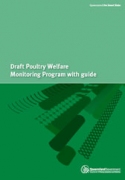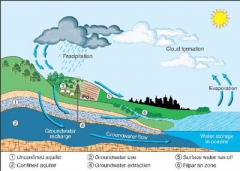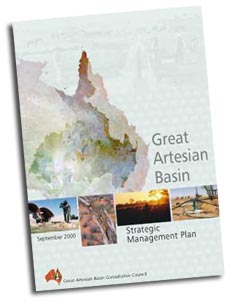
Logan and Albert Conservation Association

 The Department of Primary Industries and Fisheries (DPI&F) announced the release of the draft program for monitoring the welfare of poultry. DPI&F General Manager of Animal Welfare, Dr Rick Symons said the document is open for public comment and he is keen to hear from interested parties. "The community, poultry industry and markets for poultry products have an expectation that poultry are treated humanely," said Dr Symons.
The Department of Primary Industries and Fisheries (DPI&F) announced the release of the draft program for monitoring the welfare of poultry. DPI&F General Manager of Animal Welfare, Dr Rick Symons said the document is open for public comment and he is keen to hear from interested parties. "The community, poultry industry and markets for poultry products have an expectation that poultry are treated humanely," said Dr Symons.
"To achieve this persons in charge of poultry have a duty of care to their animals and must comply with the Poultry Standards. "The Poultry Welfare Monitoring Program is aimed at preventing animal suffering, promoting standards of animal care and ensuring that people with poultry understand and comply with the Poultry Standards. "We are keen to hear from anyone interested in making a comment to ensure the final monitoring program is acceptable to the public and industry," said Dr Symons.
To ensure compliance, the final monitoring program will include audits of poultry producers by Authorised Officers appointed by DPI&F. Industry quality assurance programs may also be approved by DPI&F if they meet the principles of the monitoring program.
The final date for public comment was Sunday 25 January 2009.
The common use of acronyms in planning documents and other professional or specialized areas can be confusing for the new reader to that subject. Shorthening a lengthy expression by saying the first letter of each word is a common occurrence in Australian language. The website acronymnfinder may be useful to help understand. SEQIRTP is here. Those who ride bicycles undoubtedly know what BUGs are.
If you are reading any of the documents attached to the South East Queensland Regional Plan or SEQRP this website may be of assistance if the acronym is not clear from the context of the document. Further links are sometimes included eg TOD or Transit Oriented Development (land development designed to encourage mass transit use) links to an article here.
Smart Growth and Transit Oriented Development are both phrases being used a great deal in government documents concerned with future planning. What is meant by these words may be difficult to understand and often depends on who uses them and the underlying pupose for their use. Planning based on these terms will affect all Queenslanders and as such each of us is entitled to comment on possible outcomes. High density housing and high-rise buildings are timely where expansion is limited by geographical features such as mountains sea and national parks but perhaps not so readily accepted where undisciplined sprawl can continue to spread across plainlands.
However the same questions of rising costs associated with oil and the provision of infrastructure, together with climate change may limit low density growth of developments in Queensland - especially in South East Queensland.
What is the Australian dream in the twentyfirst century? Where can families grow and be happy in in South East Queensland? How much open green spaces to we need? As individuals? As a community? As a society? Do we need our own or can we share? Complex questions and many answers.
Peter Newman is the Professor of Sustainability at Curtin University in Perth and a member of Infrastructure Australia's Advisory Council. His article in the Sydney Morning Herald praises Perth's new Southern Railway saying it already is something of a model for other cities. Now, 50,000 people a day are carried along a corridor that before could only manage 14,000 on buses.The Southern Railway is a model in other respects, too with some stations having transit oriented developments, or TODs. These are high density, mixed-use areas with homes, shops and offices, designed to integrate closely into the station and which can provide a local area with many city services.
 Logan & Albert Conservation Association has been advised that groups can express interest by emailing This email address is being protected from spambots. You need JavaScript enabled to view it. whereupon an information package will be distributed describing how to supply any information. We are doing this. If you do not belong to a group and have sightings to report please contact us.
Logan & Albert Conservation Association has been advised that groups can express interest by emailing This email address is being protected from spambots. You need JavaScript enabled to view it. whereupon an information package will be distributed describing how to supply any information. We are doing this. If you do not belong to a group and have sightings to report please contact us.
Contributions will be required by 13 February 2009 to the appointed study team at GHD.
NOW CLOSED but comment on QG Draft Koala Plan open until 27 February 2009
The Queensland Government is taking action to address threats to koalas in Southeast Queensland based on recommendations of the Koala Taskforce. One of the key actions recommended is to undertake extensive mapping of koala habitat in South East Queensland.
EPA Queensland Environmental Protection Agency has commenced a koala habitat assessment and mapping study across SEQ to assist in the protection of this threatened species in the region.
 Black Duck Valley is closed to customers. This petition to The Honourable Judy Spence Minister Department of Sport and Recreation has been started by individuals hoping to continue the operation of the facility: Petition Online link.can be accessed and signed here. Black Duck Valley has been a sports and recreational facility for motocross riders. Queensland population, particularly in the south-east, has grown exponentially, and sales of motocross bikes has also increased, but riders now have fewer facilities then a few years ago. Not all people are unhappy about the closure as this archived information shows.
Black Duck Valley is closed to customers. This petition to The Honourable Judy Spence Minister Department of Sport and Recreation has been started by individuals hoping to continue the operation of the facility: Petition Online link.can be accessed and signed here. Black Duck Valley has been a sports and recreational facility for motocross riders. Queensland population, particularly in the south-east, has grown exponentially, and sales of motocross bikes has also increased, but riders now have fewer facilities then a few years ago. Not all people are unhappy about the closure as this archived information shows.
 Henry Tuttiet journalist from the Jimboomba Times reported the concerns of local residents who have used the motocross park Black Duck Valley facilities for many years. It is also a concern that illegal trail bike riding in Logan City may increase as a result of the closure of this popular motocross park .
Henry Tuttiet journalist from the Jimboomba Times reported the concerns of local residents who have used the motocross park Black Duck Valley facilities for many years. It is also a concern that illegal trail bike riding in Logan City may increase as a result of the closure of this popular motocross park .
The popular park, located outside Gatton, has been forced to close down after it was unable to find insurance options to cover the park and the riders using it. Before its closure, the park was popular with trail bike riders who could legally ride on the 1500 acre property without worrying about police or disturbing nearby residents. The closure comes at a bad time for park operators and users, both of whom were gearing up for a busy Christmas period.
It is understood a group of concerned mayors from south-east Queensland, including Logan Mayor Pam Parker, Ipswich Mayor Paul Pisasale and Lockyer Valley Mayor Steve Jones, have joined forces and plan to meet with Premier Anna Bligh to discuss future options for the park.
Rising populations and incomes are expected to double the global demand for meat and milk from 229 to 465 million tonnes and 580 to 1043 million tonnes, respectively, by 2050. This will almost double the amount of greenhouse gases produced by livestock, dwarfing attempts to cut emissions elsewhere. Apart from all of us turning to a vegetarian diet, can anything be done to reduce greenhouse gas emissions from livestock?
Cows, sheep and goats may seem like innocent victims of humanity's appetite for meat, but when it comes to climate change they have a dark secret. Forget cars, planes or even power stations, some of the world's worst greenhouse gas emitters wander idly across rolling pastures chewing the cud, oblivious to the fact that their continuous belching (and to a lesser degree, farting) is warming the planet.
Take New Zealand, where 34.2 million sheep, 9.7 million cattle, 1.4 million deer and 155,000 goats emit 48 per cent of the country's greenhouse gases in the form of methane and nitrous oxide. Worldwide, livestock burps are responsible for 18 per cent of greenhouse gas emissions - more than produced from all forms of transport combined.
This article from New Scientist magazine issue 2687 is controversial but thought provoking.
 Water is vital for all of us. We depend on it for drinking, washing, recreation, agriculture and industry. Water controls the world's weather and sustains the natural systems above and below the earth's surface. But did you know that it is the water beneath our feet - something you can't see and may not even know is there - that is truly our hidden treasure!
Water is vital for all of us. We depend on it for drinking, washing, recreation, agriculture and industry. Water controls the world's weather and sustains the natural systems above and below the earth's surface. But did you know that it is the water beneath our feet - something you can't see and may not even know is there - that is truly our hidden treasure!
Some Water Facts
Where does water come from?
Water spends time in the ocean, in the air, on the Earth's surface, and under it as groundwater. This water circulates endlessly in a kind of global plumbing system called the hydrologic cycle or water cycle.
Global plumbing!
The water cycle is controlled by the sun, which produces the heat energy that determines the way the earth uses and recycles its water. This heat energy evaporates water in the oceans, lakes and even backyard pools. When water evaporates, it rises into the cooler air, collects, and forms clouds. Eventually, the water droplets that form the clouds fall from the sky as rain, snow, sleet, or hail. When water falls to the ground, it doesn't stop moving. Some flows across the earth's surface into bodies of water like rivers and lakes. Other water seeps into the soil where it makes its way to becoming groundwater, and then may slowly flow into rivers and lakes, or back into the sea. Then the cycle starts all over again! More about the water cycle is available from this CSIRO website.
If you have an interest in hydrology this page introduces you to a Hydrogeologist and includes a video about his work. The links from this page have lots of information for students.
 The Great Artesian Basin has provided water for inland areas of Australia since 1878. Basin water is extracted through bores and is the only source of water for mining, tourism and grazing in the states of Queensland, New South Wales and South Australia states, as well as the Northern Territory. The underground water returns $3.5 billion a year from farming, mining and tourism, says the Great Artesian Basin Coordinating Committee.
The Great Artesian Basin has provided water for inland areas of Australia since 1878. Basin water is extracted through bores and is the only source of water for mining, tourism and grazing in the states of Queensland, New South Wales and South Australia states, as well as the Northern Territory. The underground water returns $3.5 billion a year from farming, mining and tourism, says the Great Artesian Basin Coordinating Committee.
Recently the Australian Science Media Centre hosted a Background Briefing session which is available online. Web users can read and hear three experts discuss the issues. John Hillier's presentation is available here. There has been an enormous decrease in the pressure flow from 1800-2000 - without the addition of new needs for the planned coal extraction at Wandoan. The sleepy farming community is presently under the microscope for coal mining and a section of the Melbourne to Darwin inland rail. Planning is underway to construct the rail line from Wandoan to the port at Gladstone.
Lynn Brake's presentation is available here and shows us that the water is 2 million years old.
A 15-year Great Artesian Basin Sustainability project started in 1990 aims to protect the water supply and the hydraulic pressure necessary to access it. Today, there are still some 3,000 bores which pour water into 21,130 miles of open bore drains, with 90 per cent of the water evaporating in the outback heat. But more than 1,052 bores have now been controlled and tens of thousands of miles of open drains removed and pipelines laid, saving 272 gigalitres of water a year. Andy Love, from Flinders University in Adelaide said that an expansion in exploration and mining activities in the area will place increased demands on securing groundwater allocations for economic development. Clearly a balance between development and environmental protection needs to be achieved.
However, this is not possible without increased knowledge about the amount of groundwater that can be safely extracted.
 This article Australia's climate change plan needed to aim higher was written byDr Barrie Pittock, PSM is the former leader of the CSIRO Climate Impacts Group, and lead author of the IPCC, and author of Climate Change: the Science, Impacts and Solutions (CSIRO Publishing, 2009).
This article Australia's climate change plan needed to aim higher was written byDr Barrie Pittock, PSM is the former leader of the CSIRO Climate Impacts Group, and lead author of the IPCC, and author of Climate Change: the Science, Impacts and Solutions (CSIRO Publishing, 2009).
The Logan and Albert Conservation Association is very disappointed with the Rudd government's current position. As an individual we can each exercise our power by joining a local action group whose collective power and pupose is to bring about national reduced greenhouse gas emissions.
The Australian Conservation Foundation ACF has extensive coverage of Climate Change issues, feature articles and reports which can be accessed from this page. The media release Households to foot the big polluters' carbon bill is a difficult pill to swallow. The analysis by Innovest Strategic Value Advisors reveals that "The corporate compensation expected to go to just one company, Rio Tinto, over two years is more than the Federal Government's entire renewable energy fund."
This is not aceptable for me. Is it acceptable for you? GetUp's Spot the difference! campaign is available here if you'd like to participate.